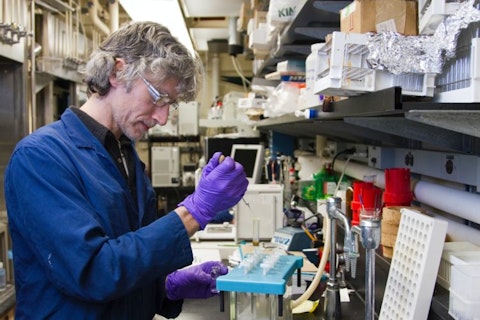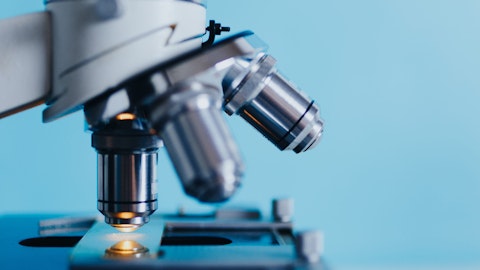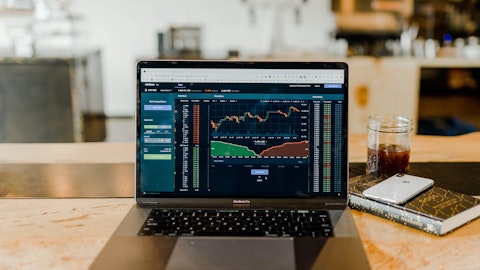Thermo Fisher Scientific Inc. (NYSE:TMO) Q4 2022 Earnings Call Transcript February 1, 2023
Operator: Good morning, ladies and gentlemen, and welcome to the Thermo Fisher Scientific 2022 Fourth Quarter Conference Call. My name is Brika, and I will be your event specialist running today’s call. At this time all participants are in a listen-only mode. A brief question-and-answer session will follow the formal presentation. Thank you. I would like to introduce our moderator for the call, Mr. Rafael Tejada, Vice President, Investor Relations. Mr. Tejada, you may begin your call.
Rafael Tejada: Good morning and thank you for joining us. On the call with me today is Marc Casper, our Chairman, President and Chief Executive Officer; and Stephen Williamson, Senior Vice President and Chief Financial Officer. Please note this call is being webcast live and will be archived on the Investors section of our website, thermofisher.com, under the heading News & Events until February 17, 2023. A copy of the press release of our fourth quarter and full year 2022 earnings is available in the Investors section of our website under the heading Financials. So before we begin, let me briefly cover our safe harbor statement. Various remarks that we may make about the company’s future expectations, plans and prospects constitute forward-looking statements for purposes of the safe harbor provisions under the Private Securities Litigation Reform Act of 1995.
Actual results may differ materially from those indicated by these forward-looking statements as a result of various important factors, including those discussed in the company’s most recent annual report on Form 10-K and subsequent quarterly reports on Form 10-Q, which are on file with the SEC and available in the Investors section of our website under the heading Financials, SEC Filings. While we may elect to update forward-looking statements at some point in the future, we specifically disclaim any obligation to do so even if our estimates change. Therefore, you should not rely on these forward-looking statements as representing our views as of any date subsequent to today. Also during this call, we will be referring to certain financial measures not prepared in accordance with generally accepted accounting principles, or GAAP.
A reconciliation of these non-GAAP financial measures to the most directly comparable GAAP measures is available in the press release of our fourth quarter and full year 2022 earnings and also in the Investors section of our website under the heading Financials. So with that, I’ll now turn the call over to Marc.
Marc Casper: Thank you, Raf. Good morning, everyone, and thanks for joining us today for our fourth quarter call and a wrap-up of a truly exceptional year for Thermo Fisher Scientific. We delivered another quarter of outstanding results in Q4, and as I reflect on the year, three things stand out to me. Our proven growth strategy continues to drive significant share gain. Our differentiated customer value proposition is further elevating our trusted partner status with our customers. And this, in combination with the power of our PPI Business System, drove outstanding financial performance for the quarter and full year, exceeding our ambitious goals. Our ability to deliver these results in a year that included global supply chain disruptions, a war in Ukraine, COVID-19 lockdowns in China and inflationary headwinds wouldn’t be possible without the incredible dedication of our team around the world.
I’m very grateful for our team’s great execution in effectively navigating dynamic times and enabling the success of our company and our customers. Thanks to our colleagues, our company delivers spectacular 2022, and I couldn’t be more excited for 2023. I’ll get into more of the details in my remarks later, but first, let me recap the financials. Starting with the quarter. Our revenue grew 7% to $11.45 billion. Our adjusted operating income was $2.56 billion, and we delivered another quarter of strong adjusted EPS performance, achieving $5.40 per share. Turning to our results for the full year. We grew revenue by 15% to $44.92 billion in 2022. Adjusted operating income was $10.99 billion and adjusted EPS, $23.24 per share. Let me turn to our end markets.
We continue to deliver excellent and differentiated performance in Q4. This was driven by a continuation of good market conditions and outstanding execution from our global team, resulting in meaningful share gain. Let me now give you some color for the quarter and the year. Starting with our largest end market, pharma and biotech, we continue to deliver impressive performance with growth in the low teens for the quarter and mid-teens for the full year. Our differentiated customer value proposition is further elevating our trusted partner status with our pharma and biotech customers. Throughout the year, we had broad-based strength across our businesses serving this end market, highlighted by our bioproduction, pharma services, chromatography and mass spectrometry businesses as well as the research and safety market channel.
In academic and government, we grew in the mid-single digits for both the quarter and for the full year. We delivered strong growth across a range of our businesses, including biosciences, electron microscopy, chromatography and mass spectrometry as well as in the research and safety market channel. In industrial and applied, we grew in the low teens for the quarter and mid-teens for the full year. During the year, we delivered strong growth in our electron microscopy and chromatography and mass spectrometry businesses. And finally, in diagnostics and health care, in Q4, revenue was approximately 40% lower than the prior year quarter and 25% lower than full year 2021. The team delivered good core business growth during the year, led by our microbiology and transplant diagnostic businesses as well as our healthcare market channel.
I’ll now turn to our growth strategy, which is delivering the differentiated performance and setting us up for an even brighter future. As a reminder, our strategy consists of three pillars: developing high-impact innovative new products, leveraging our scale in high-growth and emerging markets; and delivering a unique value proposition to our customers. Starting with the first pillar. It was another terrific year of high-impact innovation as we launched outstanding new products across our businesses that strengthen our industry leadership by enabling our customers to break new ground in their important work. In chromatography and mass spectrometry, our innovations are accelerating our customers’ research and unlocking deeper analytical insights.
In 2022, we extended our industry-leading Thermo Scientific Orbitrap portfolio, launching the Orbitrap Ascend Tribrid mass spectrometer to advance proteomics, metabolomics and cancer biomarker research. We also launched the Thermo Scientific TRACE 1600 Series Gas Chromatograph to advance analytical testing for food, environmental, industrial and pharmaceutical applications. In electric microscopy, the new Thermo Scientific Glacios 2 Cryo-TEM was launched during the fourth quarter. It will help our customers accelerate structure-based drug discovery for debilitating disorders, such as Alzheimer’s, Parkinson’s and Huntington diseases as well as research for cancer and gene mutations. We also continue to build on our genetic sciences capabilities to help our customers understand, diagnose and treat disease.
During the fourth quarter, our SeCore CDx HLA sequencing system was granted marketing authorization by the U.S. FDA for use as a companion diagnostic with a T cell receptor therapy for adults with ocular melanoma. This is a really nice example of how our Specialty Diagnostics business is benefiting from our capabilities in life sciences solutions. In addition, we expanded our PCR test menu to leverage our incredibly large installed base of instruments and launched the TruMark Infectious Disease Research Panels for rapid detection and research of infectious disease pathogens. To wrap up the innovation highlights, we added to our cell and gene therapy offering, most recently launching the Gibco CTS DynaCellect Magnetic Separation System. Our solutions are helping customers advance their cell and gene therapy programs.
So another spectacular year of innovation, and we have an exciting pipeline of launches in 2023 and beyond. The second pillar of our growth strategy is leveraging our scale in high-growth and emerging markets to create a differentiated experience for our customers. We continue to strengthen our capabilities serving these markets during the year, and I’ll highlight a recent example. In the quarter, we opened a new cGMP biologics and sterile manufacturing facility in Hangzhou, China, which provides integrated clinical and commercial drug substance and drug product capabilities to help customers in China and in the Asia Pacific region deliver patient therapies more quickly. Turning to the third pillar of our growth strategy, we continue to enhance our customer value proposition by strengthening our capabilities.
We’ve been executing on the significant investments we’ve made over the past couple of years. And throughout 2022, we brought new capacity and capabilities online for pharma services, bioproduction and clinical research services. Most recently, during the fourth quarter, we opened a new state-of-the-art bioanalytical lab in Richmond, Virginia to support our clinical research business and the increasing demand for our laboratory services to accelerate drug development. As always, our PPI Business System enabled our success during the year. It’s helping us to drive meaningful share gain, maximize the return on investments, meet our customers’ needs and successfully navigate a dynamic environment, including effectively addressing inflation and global supply chain challenges.
PPI engages and empowers all of our colleagues to find a better way every day and enables outstanding execution. We continue to successfully execute our capital deployment strategy, which is a combination of strategic M&A and returning capital to our shareholders. In 2022, we successfully integrated PPD, our clinical research business. For the full year, PPD delivered core organic growth in the high teens, generating over $7 billion in revenue and contributing over $2 to our adjusted earnings per share. The combination of a great first year performance and excellent progress on our synergy realization is delivering very strong returns for our shareholders that is well ahead of the deal model. From a customer lens, the acquisition has further elevated our trusted partner status as customers are realizing significant value in partnering with our team to advance a scientific idea to an approved medicine.
In 2022, we also returned $3.5 billion of capital to our shareholders through stock buybacks and dividends. And on the first business day of 2023, we completed the acquisition of the Binding Site, a leading specialty diagnostics company. The Binding Site is an exciting addition and highly complementary to our Specialty Diagnostic business. Together, we’ll be able to advance the diagnosis and management of patients afflicted with multiple myeloma and immune disorders. Reflecting on our progress of our ESG priorities in 2022, we further advanced our environmental and philanthropic efforts while also continuing to strengthen our company culture. During the year, we continued to advance our environmental sustainability roadmap, reducing our carbon emissions and finalizing significant power purchasing agreements to accelerate our transitions towards a 100% renewable energy.
Looking forward, we’ve also increased our 2030 greenhouse gas emissions reduction target to achieve a 50% reduction in this decade. Through our Foundation for Science, we continue to advance our philanthropic efforts and supported students across the globe during the year with our STEM education programs. This included an announcement in the quarter for the Thermo Fisher Scientific Junior Innovators Challenge, the premier middle school STEM competition in the U.S. And throughout the year, Thermo Fisher Scientific was recognized for its industry leadership and inclusive culture. This includes earning 100% score on the Human Rights Campaign 2022 Corporate Equality Index for LGBTQ equality for the seventh consecutive year as well as inclusion on Fortune’s list of the world’s most admired companies.
In the quarter, we were recognized by Forbes Magazine as one of the world’s Top Female-Friendly Companies and one of America’s best employers for veterans. As I reflect on the year, I’m very proud of what our team accomplished. 2022 is a special year for Thermo Fisher, and I’m excited about 2023 and beyond. Stephen will outline the assumptions that factor into our revenue and earnings guidance, but let me quickly cover the highlights. We’re initiating 2023 revenue guidance of $45.3 billion and adjusted EPS guidance of $23.70 per share. This very strong financial outlook reflects a continuation of our track record of delivering excellent financial performance and sustainable value creation for all of our stakeholders. So to summarize our key takeaways for 2022, our proven growth strategy continues to drive significant share gain.
Our differentiated customer value proposition is further elevating our trusted partner status. And this, in combination with the power of our PPI Business System, drove outstanding financial performance for the quarter and full year, exceeding our ambitious goals while navigating a very dynamic macro environment. And we entered 2023 with strong momentum and we’re incredibly well positioned beyond 2023. With that, I’ll now hand the call over to our CFO, Stephen Williamson. Stephen?
Stephen Williamson: Thanks, Marc, and good morning, everyone. As you saw in our press release, in Q4, we delivered an outstanding quarter, capping off another excellent year. For the quarter and the full year, we delivered 14% core organic revenue growth. This differentiated level of performance demonstrates the power of our growth strategy and the trusted partner status that we’ve earned with our customers. In addition, in Q4, we generated $370 million of COVID-19 testing revenue, $3.1 billion for the full year. Taking a step back and thinking about the top line performance for the year, I’m really proud of what the team delivered. We offset $4.2 billion less testing revenue, which was a headwind of over 10%, and still delivered slightly positive organic growth for the year.
That’s a great accomplishment. Then using the power of the PPI Business System, we were able to translate the top line strength to excellent adjusted EPS and cash flow results. In Q4, we delivered $0.23 more adjusted EPS than our prior guide, ending the year at $23.24 and delivered $6.94 billion of free cash flow, all while continuing to invest in the business to enable an even brighter future. So 2022 was another excellent year. Let me now provide you with some details on our performance. Beginning with the earnings results. As I mentioned, we delivered $5.40 of adjusted EPS in Q4 and $23.24 for the full year. GAAP EPS in the quarter was $4.01 and $17.63 for the full year. On the top line as I mentioned in Q4, we delivered 14% core organic revenue growth and $370 million of testing revenue.
Reported revenue grew 7% year-over-year. The components of our Q4 reported revenue increased included 3% lower organic revenue, a 14% contribution from acquisitions and a headwind of 4% from foreign exchange. The full year core organic revenue growth was 14% and we delivered $3.1 billion in testing revenue. For the full year 2022, reported revenue increased 15%. This includes slightly positive organic growth and 18% contribution from acquisitions and a 3% headwind from foreign exchange. Turning to our organic revenue performance by geography. The organic growth rates by region are skewed by the COVID-19 testing revenue in 2022 and the prior year. In Q4, North America grew in the low single digits. Europe declined in the low teens. Asia-Pacific in the mid-single digits with China declining in the mid-single digits and rest of the world declined high single digits.
For the full year, North America grew in the low single digits. Europe declined high single digits. Asia Pacific grew high single digits, including China, which also grew high single digits for the year, and the rest of the world declined high single digits. On a core organic growth basis, all regions had strong growth in 2022. With respect to our operational performance, adjusted operating income in the quarter decreased 19% and adjusted operating margin was 22.4%, 710 basis points lower than Q4 last year. For the full year, adjusted operating income decreased 9% and adjusted operating margin was 24.5%, which is 650 basis points lower than 2021. For both the fourth quarter and full year, we achieved strong price realization to effectively address inflation, while also delivering strong productivity.
This is more than offset by lower testing volumes, continued strategic investments and the expected impact of incorporating PPD into our financials. For 2022, full year adjusted operating margin was 40 basis points lower than assumed in the prior guidance. Two-thirds of this was due to business and currency mix and a third due to one-time costs related to the runoff of testing revenue. Total company adjusted gross margin in the quarter came in at 41.4%, 910 basis points lower than Q4 last year. For the full year, adjusted gross margin was 43.5%, down 810 basis points versus the prior year. For both the fourth quarter and the full year, the changing gross margin was due to the same drivers as those of our adjusted operating margin. Moving on the details of the P&L.
Adjusted SG&A in the quarter was 15.6% of revenue, an improvement of 170 basis points versus Q4 2021. For the full year, adjusted SG&A was 15.8% of revenue, an improvement of 130 basis points compared to 2021. Total R&D expense was $390 million in Q4. For the full year R&D expense was $1.5 billion, representing 5% growth over the prior year, reflecting our ongoing investments in high impact innovation. R&D as percent of our manufacturing revenue was 7% in Q4, 6.4% for the full year. Looking at results below the line for the quarter and net interest expense was $119 million, which is $31 million favorable to Q4 last year. Net interest expense for the full year was $454 million, a decrease of $39 million from 2021. Adjusted other income/expense was a net expense in the quarter of $10 million compared to net income of $7 million in Q4 2021.

Photo by National Cancer Institute on Unsplash
The year-over-year variance is primarily due to changes in non-operating FX. For the full year, adjusted other income and expense of the net income of $14 million, which is $24 million lower than the prior year. Our adjusted tax rate in the quarter was 12.8%, which is a 100 basis points lower than Q4 last year, reflecting the results of our tax planning activities. For the full year, the adjusted tax rate was 13% or 160 basis points lower than 2021. We repurchase $1 billion of shares in Q4, bringing our total repurchases for 2022 to $3 billion. Average diluted shares were $393 million in Q4, approximately 4 million lower year-over-year driven by share repurchases net of option dilution. Turning to cash flow on the balance sheet. Full year cash flow from continuing operations was $9.15 billion.
Free cash flow for the year was $6.94 billion after investing $2.2 billion of net capital expenditures. We returned $118 million to shareholders through dividends in the quarter and $455 million for the full year. We ended the quarter with $8.5 billion in cash and $34.5 billion of total debt. Our leverage ratio at the end of the quarter was 2.9 times gross debt to adjusted EBITDA and 2.2 times on a net debt basis. Concluding my comments on our total company performance, adjusted ROIC was 13.5%, reflecting the strong returns on investment that we’re generating across the company. Now I will provide some color on the performance of our four business segments. Let me start with a couple of framing comments. The scale and margin profile of our COVID-19 testing revenue varies by segment.
And the testing revenue was significantly higher in the prior year. That does skew some of the reported segment margins. We’re executing strong pricing realization across all segments to address higher inflation. And we’re referring to the acquired PPD business as our Clinical Research business, and that resides in the Laboratory Products and Biopharma Services segment. The anniversary date of the acquisition was December 8. Moving on to the segment details, starting with Life Sciences Solutions, Q4 reported revenue in this segment declined 27%, and organic revenue was 24% lower than the prior year quarter. In Q4, we delivered very strong growth in our bioproduction business. This was more than offset by the moderation and testing revenue in the segment versus the prior year quarter.
For the full year, reported revenue in the segment declined 13% and organic revenue declined 12%. Q4 adjusted operating income in Life Sciences Solutions decreased 48% and adjusted operating margin was 34.1%, down 14 percentage points versus the prior year quarter. In Q4 we had unfavorable volume mix due to the significantly higher testing revenue in the prior year quarter. And for the full year, adjusted operating income decreased 29% and adjusted operating margin was 41.2%, a decrease of 880 basis points versus 2021. In the Analytical Instruments segment, reported revenue increased 9% in Q4 and organic growth was 14%. A strong growth in the segment this quarter was led by electron microscopy and the chromatography and mass spectrometry businesses.
For the full year, reported revenue in the segment increased 9% and organic revenue increased 14%. Q4 adjusted operating income in the segment increased 25% and adjusted operating margin was 25.4%, up 330 basis points year-over-year. In the quarter, we delivered strong volume pull through and productivity. This was partially offset by strategic investments. For the full year, adjusted operating income increased 26% and adjusted operating margin was 22.8%, up 310 basis points versus 2021. Turning to our Specialty Diagnostics segment. In Q4, reported revenue declined 23% and organic revenue was 20% lower than the prior year quarter. In Q4, we continue to see strong underlying growth in the core led by a healthcare market channel and our transplant diagnostics and microbiology businesses.
This was offset by lower COVID-19 testing revenue versus the year ago quarter. For the full year, reported revenue in the segment decreased 16% and organic revenue was 13% lower than 2021. Q4 adjusted operating income decreased 30% in the quarter and adjusted operating margin was 18.6%, down 190 basis points versus Q4 2021. During the quarter, we delivered strong productivity, which is more than offset by the impact of lower testing volume. For the full year, adjusted operating income decreased 20% and adjusted operating margin was 21.5%, down 110 basis points versus 2021. Finally, in the Laboratory Products and Biopharma Services segment, Q4 reported revenue increased 42%. Organic growth was 11% and the impact of acquisitions was 35%. During Q4, organic revenue growth in this segment was led by the Pharma Services business.
PPD at Clinical Research business continued to perform very well, and during the quarter it delivered over 20% core organic revenue growth and contributed $1.9 billion of revenue to the segment. For the full year, reported revenue in the segment increased 51% and organic revenue increased 10%. Q4 adjusted operating income in the segment increased 73% and adjusted operating margin was 14.1%, which is 260 basis points higher than Q4 2021. In the quarter, we drove favorable business mix and delivered strong productivity and volume pull through that was partially offset by strategic investments. For the full year, adjusted operating income increased 56% and adjusted operating margin was 12.8%, up 40 basis points versus 2021. Let me turn to our 2023 guidance.
As Marc outlined, we’re starting the year with a very strong financial outlook consisting of revenue guidance of $45.3 billion and adjusted EPS guidance of $23.70. Let me provide some details to the underlying assumptions starting with revenue. Our initial guidance for 2023 assumes 7% core organic revenue growth, $400 million in testing revenue, $250 million of revenue from acquisitions and a tailwind of $100 million from FX. This all assumes a return to more normal market growth conditions in 2023 in the range of 4% to 6%. Within our core revenue, we expect $500 million of vaccines and therapies revenue in 2023. This is $1.2 billion less than 2022, a 3% impact on core organic growth. Even with this headwind, we’re expecting to deliver 7% core organic revenue growth in 2023, demonstrating the strength of our initial outlook, the agility with which we’re managing the business and the ongoing benefits of our growth strategy.
Turning to profitability, in 2023, we’re assuming an adjusted operating margin of 23.9%. This is 60 basis points lower than 2022, driven by two elements, a 40 basis points of core margin expansion and a 100 basis point headwind from the runoff of testing revenue. The year-over-year margin change is consistent with the comments I have made on the last earnings call were not described have to model a margin impact to the different elements of the year-over-year change in revenue. In 2023 with a pandemic related testing revenue behind us, I thought this would be a good opportunity to take a step back and take a multi-year view on our meaningful margin expansion progression. Starting in 2019, pre pandemic, excluding the impact of PPD, we’re on track to expand operating margins, 60 basis points a year on average through 2023 and 250 basis point improvement over the full year period.
It’s a great progress on margin expansion. Turning to adjusted EPS. We expect to deliver $23.70 in 2023. This is a 2% year-over-year increase consisting of a 10% headwind from testing more than offset by a 12% increase driven by the core business. We’re actively managing the whole P&L to effectively deal with material runoff in testing and vaccines and therapies revenue, and still grow our adjusted earnings per share for the year. This shows the strength of our growth strategy and the power of our PPI business system. Moving on to some more detailed assumptions behind the guide. With regards to FX in 2023, we’re assuming it’s a year-over-year tailwind of approximately a $100 million of revenue or 0.2% and $0.04 to adjusted EPS also 0.2%. We’re assuming that The Binding Site acquisition will contribute approximately $250 million to our reported revenue growth and $0.07 to adjusted EPS in 2023.
Below the line, we expect net interest expense in 2023 to be approximately $480 million. This approximately $25 million higher than 2022 and includes the funding for the Binding Site acquisition. We assume that the adjusted income tax rate will be 11% in 2023. The improvement from 2022 is driven by a tax planning initiative. We’re expecting net capital expenditures will be approximately $2 billion in 2023 and free cash flow is assumed to be $6.9 billion for the year. In terms of capital deployment, our guidance assumes $3 billion for share buybacks, which were already completed in January. We estimate the full year average diluted share count were approximately 388 million shares. We’re assuming that we’re return approximately $540 million of capital to shareholders this year through dividends.
And as is our normal convention, our guidance does not assume any future acquisitions or divestitures. And finally, I wanted to touch on quarterly phasing for the year. Revenue adjusted operating margin and adjusted EPS are all expected to ramp up as we go through the year. This is due to several factors. Core organic revenue growth is expected increase as we go through the year, largely due to the comps related to vaccines and therapies as well as the expected phasing of economic activity in China. The impact of the runoff in testing revenue is most pronounced in Q1 and the benefits of the offsetting cost actions are spread over the year. From a foreign exchange standpoint while a slight tailwind for the year as a whole in Q1, FX is expected to be a year-over-year headwind of approximately $200 million of revenue and $80 million of adjusted operating income.
Below the line, net interest expense is expected to decrease during the year as we generate free cash flow and interest on that cash build. Putting all this together for Q1, we expect core organic revenue growth to be in the mid-single digits. Adjusted operating margin to be slightly lower than Q4 2022 and adjusted EPS to be just over 20% of the full year total. So to wrap up, we had an excellent 2022 and we’re really well positioned to continue to deliver differentiated performance for all our stakeholders in 2023. I look forward to updating you on our progress as we go through the year. With that, I’ll turn the call back over to Raf.
Rafael Tejada: Thank you, Stephen. Operator, we’re ready for the Q&A portion of the call.
See also 11 Most Undervalued Foreign Stocks To Buy and 15 Most Undervalued NASDAQ Stocks.
Q&A Session
Follow Thermo Fisher Scientific Inc. (NYSE:TMO)
Follow Thermo Fisher Scientific Inc. (NYSE:TMO)
Operator: Thank you. The first question we have from the phone lines comes from Jack Meehan of Nephron Research. Your line is now open.
Jack Meehan: Thank you. Good morning. I wanted to start with the clinical research, PPD, performance. So high teens for the year, that’s well above what we’re seeing from the pure group, so a three-parter for you, Marc. What was your book-to-bill in 2022? Two, how are the revenue synergies tracking? And then three, can you talk about what sort of growth you’re assuming for this business in 2023?
Marc Casper: Sure. So Jack thanks for the question. Our clinical research group has performed incredibly well, a great first year as part of the company, exceeding our own high level of ambition for the business. Integration has gone smoothly. Customers really see the obvious fit with the company, and it really has driven very strong momentum. And our colleagues are very excited about the combination. So as I think about the different elements of performance, the book-to-bill was very positive. Authorizations were very strong in the quarter and the year. So we entered the year with very strong momentum in terms of the backlog that we have in the business and the authorizations. The revenue synergies, the way I would think about it is in two phases because of the long-cycle nature from a win to revenue.
We’ve won extremely substantial revenue synergies that will show up in the financials in 2023 and beyond. We had a small amount of revenue that came into the numbers last year, but we’re talking in the hundreds of millions of dollars of wins that we’ve achieved from an authorization standpoint, so extremely positive. And in terms of our thoughts about 2023, it will grow above of the company’s average of the 7% growth that we outlined in the course. So a nice contributor to the success. And really, it’s been a seamless integration for the team. We’re very grateful for that.
Jack Meehan: Excellent. And then I wanted to ask about the COVID vaccines and therapeutics. So you’re assuming $500 million for the year. My question is simple. Just how core are your core sales? Would you ever consider changing this definition? Just confidence in the handoff as it pertains to bioprocessing in 2023?
Marc Casper: Yes. So, Jack, thanks for the question. But when I think about the $500 million, right, and when I look at that, that number is primarily related to our pharma services activity. It’s around actually producing the active pharmaceutical ingredients for the therapies. It’s for the sterile fill finish primarily for the vaccines and some of the therapies. So we have pretty good visibility to that number. So I feel good about that. We decided back, I guess, 1.5 years ago or whatever the exact timeframe we did, the definition of core was we invested in capacity. And if you think about a sterile fill finish line, as an example, can be used for a COVID vaccine. It can also be used for pretty much any other biologic and even some of the small molecules, right?
And therefore, our view was we would transition that capacity over time and we have been and we will. The other aspect of core is that if you think about how strong our growth was last year, well above our own ambitions. Even the 12% we had laid out at the end of the third quarter, we’ve already transitioned a meaningful amount of that revenue in terms of other activities. So we didn’t contemplate at all about changing the definition of what success is. We think 7% is the right number for us. The core is the right definition for us. We’ll provide transparency during the year about the different components as we always do, so that investors can understand how we’re getting there. But I feel great about the outlook, and I’m very proud of what the team delivered last year.
Thanks, Jack.
Jack Meehan: Excellent, thank you.
Operator: Thank you. We have the next question from Patrick Donnelly of Citi. Your line is now open.
Patrick Donnelly: Hi, good morning, guys. Thank you for taking the questions. Marc, maybe one on the Analytical Instruments business, 14% growth for the year is obviously pretty impressive. You guys have seen elevated growth for a good stretch here. It did step down a little bit against an easier comp. So I just wanted to get more color, I guess, on what you’re seeing on the demand side, how you’re seeing order trends and bookings there, visibility into 2023. I know you’ve had this elevated backlog we’ve talked a lot about. It seems like some peers are expecting kind of a normalization or moderation in the second half as we work our way through the year. So I want to get your perspective of what you’re seeing there.
Marc Casper: Yes. Patrick, thanks for the question. So when I think about the Analytical Instruments business, a really strong year, excellent execution. There’s nothing different in Q4 than in Q3. So I wouldn’t read anything into that. When I look at what’s driving it, last year, you saw good market conditions. Funding was clearly strong. I don’t know if there was a little bit of pent-up demand from 2020, I don’t know. But the funding was clearly available. We did very well with our innovation, right? We stayed committed to innovation throughout the early phase of the pandemic, making sure we have robust pipelines. You saw that in the stream of launches in our chromatography, mass spectrometry and electron microscopy businesses, those products have been well adopted.
We’re clearly growing very well. And as you know, we’ve also built out a very strong presence in enabling the next generation of semiconductors, battery applications. The most advanced aspects of material science is a different market position than really anybody else has in the industry and that’s driving great growth, right? And you can see it in our electron microscopy numbers. I’m very proud of how the team has executed. So, that’s kind of the context of why the elevated growth. So as I think about bookings demand, very strong throughout the year. So we have good visibility to the first half. It’s when those most of those orders will ship. We would expect that the Analytical Instruments business will be a really nice contributor to our growth for the year.
And I think it’s reasonable to assume that the growth normalizes more in the second half as an assumption. It’s not that I see something different or something happening in the market conditions, but our visibility is typically six months. So at the end of the first quarter, we’ll have good visibility into the third quarter, and we’ll keep you posted. But I think for modeling purpose, I think, normalization in the second half is a good assumption.





